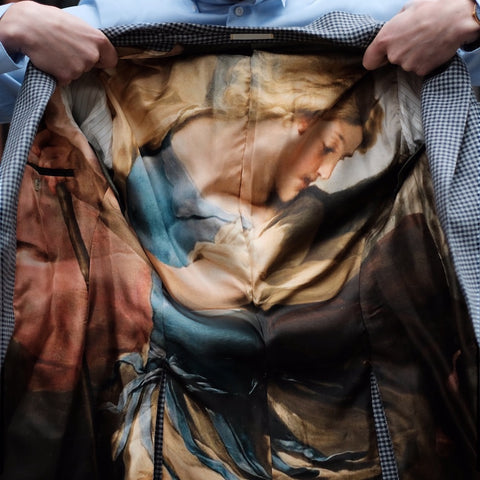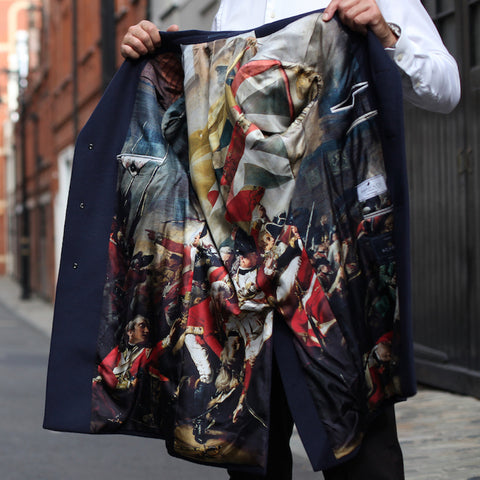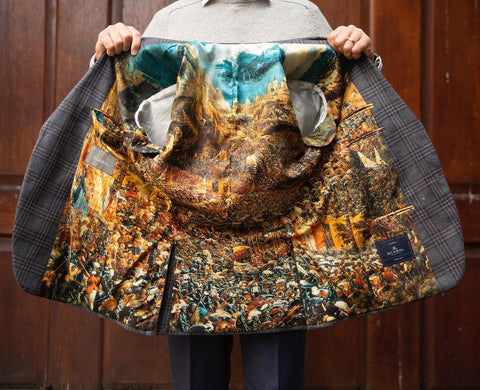Our Guide To Jacket Linings - Fabric Types, Half vs Full Linings, Design Options
When it comes to men's jackets, the lining is often an overlooked feature. But the truth is, the lining can make a huge difference in terms of comfort, durability, and style. In this blog, we'll take a deep dive into the world of men's jacket linings and explore everything from their history, to how they're made, and what they're made from.
QUICK LINKS
- The History of Jacket Linings
- How are Jacket Linings Made
- Half-lined vs fully-lined
- Different Fabric Options
- Design Options Available
- Bespoke Jacket Linings
- The Benefits of a Jacket Lining

The History of Jacket Linings
Jacket linings have been around for centuries, although they haven't always been used for the same reasons they are today. In the past, linings were primarily used to protect the garment from perspiration and oils produced by the body. They were also used to add warmth and make the jacket more comfortable to wear.
Over time, jacket linings became a way to add style and personality to a jacket. Today, you can find linings in a variety of colours and patterns, from classic stripes and plaids to bold prints and solids. We have added a further twist with our Fine Art Jacket Linings.

How are Jacket Linings Made

There are two main types of jacket linings: fused and sewn. Fused linings are created by applying a layer of adhesive to the back of the lining fabric and then pressing it onto the jacket fabric. This creates a smooth and flat lining that doesn't require any stitching. Fused linings are often used in more affordable jackets, and are easier and faster to produce.
Sewn linings, on the other hand, are created by cutting the lining fabric into the same shape as the jacket and then sewing the two pieces together. This process is more time-consuming and labour-intensive, but it creates a higher-quality lining that is more durable and comfortable to wear.
What are Jacket Linings Made From
Jacket linings can be made from a variety of materials, including silk, polyester, cotton, and rayon. Silk is often considered the gold standard for jacket linings because it is soft, lightweight, and breathable.
Polyester is a popular choice for jacket linings because it is affordable, durable, and easy to care for. It also comes in a wide range of colours and patterns, making it a versatile option for jackets of all styles.
Cotton and rayon are also common lining materials, with cotton being a more breathable option and rayon being more lightweight and moisture-wicking.
HALF-LINED VS. FULLY-LINED
Do not be tempted to dismiss the idea of the half-lined jacket off-hand, believing it to be some compromise or half-measure, a money-saving option or a way to test the water. The half-lined jacket may very well be the option that a currently unlined jacket requires. Here’s why:
As I write this blog post, autumn has ceased its flirtations and has finally fixed itself fully to the landscape, and the presence of the evening is felt in sudden drafts, misting windows and the sound of tepid rain drumming gently on the windowpanes.

In the warmer months, a half jacket means less sweat, and with that, no hideous and unsightly reservoirs of sweat will puddle our shirts. No heat is trapped, and we stay cooler and drier since the inside of our jacket is not fully enclosed.
Neither is airflow constricted, so a summer breeze can pass through the cloth, and you’ll be kept cooler than if you opted for a fully-lined jacket.
Which, as a quick glance inside your wardrobe would surely confirm, will be most days, even those that entice the mercury into the upper echelons. Most tailors, clothiers and designers much prefer to sell us a fully lined jacket, as a matter of aesthetics. A common question often asked is, what does full lining mean? Simply put, the whole jacket is lined, the back, side sections and sleeves. Half-lined jackets have mostly the same apart from the bottom section of the jacket inner lining. Where there is a fully lined suit jacket, the eye won’t see a single unseemly stitch.

But the issue of ventilation during spring and summer means that, especially since the back is constantly pressed against the jacket, you ought to at least own a half-lined jacket or two.
And if tweed is a cloth that speaks to your own particular style, then nothing less than a half-lining should be considered if you plan to wear such a jacket season to season.
What Lining Works Best In a Blazer?
Blazer lining works in the same guise as a tailored jacket in terms of fabric types, lining options and overall appearance. The main difference you will find is the higher use of unstructured blazers vs a tailored jacket. Why? The clue is in the wording, as significantly less tailoring expertise is used within an unstructured blazer, meaning there is little or no blazer lining fabric. Half-lined blazers work brilliantly for dinner or evening jackets to make a statement and clean finish.

Why Line a Jacket?
In one of his many adoring letters to his soon-to-be wife, the great author Vladimir Nabokov wrote that masterful poetry removes the cloak of invisibility masking life’s magical mechanics. If we ponder the complexities of love, of death, of art, of anything, we’ll need to use the illuminating power of poetry to satisfy our enquiry.
Nabokov’s theory, then, is: that which we can’t see conceals the secret to things that we admire, things that we long for, things that bewitch us. And so it is with the lining of a suit jacket. Our full jacket lining range can be found on the following link: Jacket Lining Collection.
A slight sigh of relief may be emitted here, because, happily, we won’t need to be masterful poets for our mortal eyes to locate this particular wizardry. Return your book of Byron to the shelf. The reasons that lining enhances a jacket are absolutely perceptible and surpassingly practical. We simply need to take a second glance and a seconds thought to appreciate how we can profit from a well-lined suit jacket.
First, the practical benefits. It is a widely held misconception that this thin layer of material is only used for aesthetic purposes. However, a tailor will look at a jacket lining as a fabric utilised to support the garment. The jacket lining fabric has to be carefully considered to the overall appearance of the garment to ensure its quality and durability.
It has only been in more recent times that the lining has added a decorative element to the jacket, and this is indeed a delightful thing, furnishing a jacket with meaning, personality and elan; each of these would more than justify the desire to line a suit jacket. Why wouldn’t we want our garments to radiate such things?
But we detour to design before this digression is scheduled, so back we go to those practicalities. What are they?
You might notice that the very best looking suit jackets have a certain gravitas, weight and shape that anchors the entire look of a suit. You can attribute much of this ‘feel’ to a good jacket inner lining, which fortifies the structure and adds weight and heft, which is illustrated in the jackets below.
It may seem counter-intuitive, in fact, much of tailoring initially does, but the addition of the extra weight allows the garment to better sit along the contours of the body. In short, it’ll help you look good. And that, in the end, is what we want from a suit, is it not?
It is also worth noting that a lined jacket is much harder to crease, meaning the slight fear of leaving the house in pristine elegance but arriving crinkled and crimped, a fear that quietly haunts all regular suit wearers, is buried. It’s the extra fabric between the torso and jacket we thank for this sustained and flattering neatness. Feel at liberty, then, to strut carelessly (Well, a little cautiously perhaps. But only a little).
A good suit is, of course, something of an investment. Many of us, on purchasing a new suit, hope for style in longevity. And here again, the lining is our invisible hero, helping to not only shape the garment but also adding a strength that will elongate the life of the jacket.
Lastly, those who believe a fine garment should absolutely and without compromise conceal the unsightly, rejoice - interlinings, stitching and raw edges are all deftly hidden by a fully lined jacket. A properly constructed jacket, to sit perfectly on the body, is quite a complex construction and a lining allows the remaining evidence of that complexity to be neatly hidden.
Design Options Available
Below famous New York tailor Leonard Logsdail outlines what can make a lining truly special and why he chooses to work with our linings.
Which brings us to silk and the question of customisation.
Any custom lining fabric makes good sense, since most linings are, to be frank, a little too standardised. They are block colours. They are paisley, occasionally striped. And that’s usually it. There right printed suit lining fabric can bring any pattern or artwork to life within tailoring.
However, since we are, by choosing our lining, customising the jacket, why not truly make it your own? Why not individualise the jacket to represent your personality and particular style?

Why not, in fact, have your lining illustrate something that stirs the soul, speaks of a time, a place, a feeling? There is no need to opt for a block colour - so why do it when we have the chance to create for ourselves something more?
If we are going to individualise and customise in such a fashion, elevating the garment into something that may be cherished through the decades, surely there can be no other material to use than silk.
A little history and a word on contemporary customisation. Since Madeleine Vionett matched her outer fabrics with the inner lining for Chanel in the 1920s, the idea of stylised and personalised lining nagged at designers who began to think more carefully about seldom seen detail, not least in the form of the lining.
Eventually, this led to fashion houses like Yves Saint Laurent offering customisation. But by the 1950s customisation was spared only for the odd college sports jacket in the US, or very special and very expensive suit or evening dress.
But that’s changed and customisation is being offered by the most fashionable and cutting edge brands as a matter of course. In the latest collections from Louis Vuitton, we now have the option to customise garments with our initials. Other high-end designers, notably Gucci, have also introduced this service, from jackets to luggage to holiday wear and accessories.
For the consumer, it’s good news; we get to make the garment our own, giving us a sense we are not spending fortunes to simply don the exact same clothes as everybody else.
For the designer, it’s also good news since consumers are happy to pay a fair price to not simply don the exact same clothes as everybody else. Sportswear companies have been doing very nicely from this service for a good decade.
For these reasons (and if we want to intellectualise the argument we could point to the ever-ever-increasing individualisation of society) it’s been suggested by the hipper fashion outlets that customisation is the future of fashion.
And it makes sense. If we can have a bigger say in how our garments look, let's. It is with this in mind we have now launched our own range of 100% silk jacket linings, ready to be lined into a jacket of your choosing. True to our company values, we want to create, or play a part in creating, products that truly speak to their owner.
Examples of Our Silk Jacket Linings
The collection of printed silk lining fabrics utilises beautiful works from the collections of the National Gallery, the British Museum and the V&A among others. We will also be offering repeat patterns that will be sold by the metre.
Our full range of jacket lining can be found on our collection page here. For any questions email us on bespoke@rampleyandco.com.
Shop the Collection: Silk Jacket Linings
Below is an example of our printed silk lining fabric The Annunciation by Giordano used by the renowned New York bespoke tailor Leonard Logsdail. Generally, tailors will prefer to work with two panels for a painting so that the key elements of the painting can be lined up down the back seam.
The lining below is taken from the painting The Last of the Buffalo by Albert Bierstadt, painted in 1888. The lining artwork is really quite versatile across a range of fabrics, from mens linen jackets to a wool-blend suit. This jacket has been created by Scabal of Savile Row.
In the below images, Gownsmith of London have produced a beautiful overcoat, using our Destruction of Pompeii and Herculaneum silk coat lining.
The Pros and Cons of Different Fabrics
You may be wondering as you read through this article and explore various product options ‘what is the best suit lining fabric?' The different choice of materials for a suit lining is straightforward enough, with silk traditionally being favoured where possible, however, there are a number of different types of lining, generally determined by the price point of the finished garment.
Polyester lining is commonly considered the cheapest and most affordable option available, and is often seen on the high street. The best suit lining fabric is that which is durable, can be printed on in high quality, and adds structure to your jacket.
Acetate Linings
First up, the increasingly popular synthetic acetate, and its close variations. The high-street increasingly manufactures off-the-shelf lined jackets using acetate. Unsurprising, since it's simple enough and cheap enough to mass produce.
It’s not an especially durable material. It can tear with little resistance and can fade with regular use. It’s not a lining one could endorse with absolute enthusiasm, however, on the plus side it is resistant to wrinkling and draws moisture away from the body.
Bemberg Linings
Bemberg, however, is dependable and perhaps the most well known of all contemporary mid-high price lined jacket. It ‘imitates’ silk well, in fact, it’s sometimes referred to as Bemberg Silk, although it's actually made from cotton.
It’s only notable disadvantage is that it’s not silk, yet commands a high-price when purchased separately for a lining. And, as it’s still natural and expensive, the question is why pay more than regular synthetic prices but then own a jacket not bestowed with the luxury, history and romance of silk?
Polyester Linings
On to polyester. A couple of springs ago, I made the imbecilic error of hurriedly borrowing a suit jacket from a friend that looked refined from distance (thinking back, perhaps that distance was something like several thousand miles) but on closer inspection (merely five hundred miles away) transpired to be cheaply and badly made.
It was a wool suit jacket with a polyester lining. The temperature outside couldn’t have exceeded fifteen degrees. Yet I sweated like it was a hundred and fifty. It was like wearing a radiator. I was a sauna in sheep’s clothing. Even when removed, it slumped in a chair collapsed and perspiring, like a marathon runner. I have no idea where that jacket is now but I guarantee you it’s sweating all by itself...
I can offer no suggestion as to why it’s used as a lining other than the obvious; its low cost. That tailors and designers opt to do so, that have much better options available for not a lot of extra cost, will forever baffle many of us, me included.
Silk Linings
Finally, to silk. The best suit lining fabric and gold standard for jacket linings materials, that offer both the performance, along with, as importantly, the romance of a fabric that has been used and admired in jacketing for hundreds of years. Compared to other lining materials, silk may be more costly than the cheaper synthetic alternatives available, but if you are purchasing a quality garment, why would you choose to skimp on a critical element of the final product? If one was fortunate enough to be buying a Ferrari, it is unlikely that you would choose to replace the engine with that of a Fiat Punto...
We would argue, that silk should be your first, only and last choice when it comes to your jacket lining. Now, we’re not going to present silks as the impeccable lining material. In fact, there are some who would, were money to be no option, still plump for Bemberg.
However, silk offers comfort and practicality, of course. And it carries a romantic or personalised customisation like no other fabric. It itself is loaded with history and romance and notions of luxury and class. In this sense, Bemberg, I would forever argue, doesn’t compete.
Essentially the face-off is between the prosaic nature of cotton versus the history, poetry and romance of silk.
Bespoke Jacket Linings
In addition to the silk panels available on our website, we also now offer a bespoke service. This means we can create an image or painting entirely of your choosing to graciously line your jacket, or even your coat. Utilising silk as a canvas ensures we can create jacket and coat linings with exceptional detail, allowing you as the consumer to create truly one of a kind products.
Below are some images of a bespoke jacket created for a private client that wanted The Birth of Venus by Sandro Botticelli as a lining. As you can imagine, we're absolutely delighted at how beautiful the end result is.
The use of a custom lining fabric can add creative flair to your jacket and outfit, add a luxury finish and ensure you receive the exact item you envision of creating. In our opinion, silk works best for a printed suit lining fabric as it has the right properties for a high quality print definition and a rich texture to capture different colour levels.
For any questions around our bespoke linings email us here: bespoke@rampleyandco.com.
Conclusion
In conclusion, a jacket lining fabric plays a much larger part than meets the eye. Not only does it provide structure to the jacket and removes moisture from the body, but it also provides an aesthetic role in hiding some of the construction elements of the finished garment.
Lining fabrics differ in terms of design, style and benefits, Although there are quite a few options we clearly love the romanticism of silk, and by using a customised lining, you can create something truly unique and meaningful.
Shop the Full Jacket Lining Collection
Guide to Buying a Tailored Jacket Online

"I was elated when I received the most elegant and exquisite pocket square I had ordered from Rampley & Co! It is absolutely gorgeous. The color and clarity of the scene depicted, and the quality of this accessory are truly exceptional." Read more reviews...
"Very impressed by both the quality of the product and the customer service. The team fulfilled a last-minute request and got a beautiful pocket square to me via international shipping nearly instantaneously." Read more reviews...
"I recently purchased a scarf for my wife´s Birthday and a pocket square for myself. We could not be more pleased. The items arrived promptly, beautifully presented and I received a surprise with my pocket square." Read more reviews...































